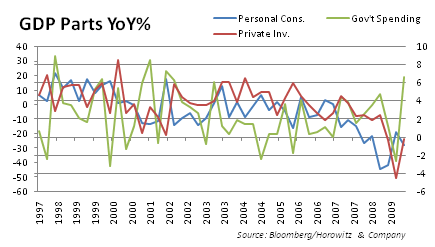The final numbers were released today for the second quarter’s GDP. The fascination with GDP is becoming more and more obvious and the media just loves to announce when a country moves positive as it can headline that “RECESSION IS OVER!”
We know better though. Even though the recession is over it does not change anything. It is kind of like a birthday. When you turn 40, 42, or 68 it is a milestone. But does anything really change? All along we knew you were getting older and now that the birthday arrives you are NOT a year older, you are a day older than yesterday.
So, don’t get caught up in the media’s fascination with this. Look at the components and trends.
Dismal.com had a good summary:
Signs of recovery in GDP bolster our confidence that growth will rebound in this year’s second half. Contrary to expectations, the percentage change in real GDP in the second quarter was revised higher from -1% to -0.7% in the government’s third and final estimate.
We had expected a downward revision to -1.4%, and the consensus had expected -1.1%. Nonresidential construction figures were revised downward as projected. However, inventories were lowered only slightly, and consumer spending and equipment and software investment were unexpectedly revised upward, and the trade balance came in narrower than expected.
The revisions present a composition of economic activity that is better for future growth. The biggest surprise in the report was the rebound in high-tech investment: Real spending on information processing equipment and software rose 5.5% at an annual rate in the second quarter, revised substantially from the prior estimate of -1.3%. Real final sales were revised from 0.4% to 0.6%, and the change in real inventories at an annual rate was a record $160 billion, though we had expected a larger decline. Still, a reduced pace of inventory liquidation should provide the necessary lift to push GDP growth up to 3% this quarter.
A number of developments suggest that the trajectory of final sales is looking better as the year winds down, a positive for growth as we head into 2010. Foreign demand indicators have surprised to the upside, home sales and construction are rebounding, and equipment spending is stabilizing. With the end of the cash for clunkers program, vehicle sales are expected to recede, and consumer spending is expected to end the year weaker, but an improving labor market should clear the path for a sustained rebound in consumer spending.
Revised corporate profit figures, also released with this report, put growth in pretax corporate profits down to 3.7% (not annualized) from 5.7% and from a 5.3% rise the quarter before. The entire downward revision was accounted for by a smaller rise in financial industry profits, which still have more than doubled from their low set in last year’s fourth quarter. The rise in nonfinancial profits was revised to 4.7% from 4.5%. The forecast looks for earnings to improve further in the third quarter as GDP and revenue growth turn positive. Improving profits and revenues are key to encouraging businesses to start hiring. Along with better financial market performance, this shift in behavior should help sustain growth in 2010.
If you look at the chart below, there is a significant amount of government spending that is shown. Sure, money is money and profits are profits, but there is a difference between organic growth and synthetic growth.
Government spending is synthetic and temporary. It has to be or else there is no free market economy. Already we are planning every stock, bond and other investment acquisitions with governmental spending in mind. We ask how it will effect the dollar, oil and inflation with every analysis. This is not something that had to be done before and something that can hopefully be discontinued soon. (How we pick our investments HERE)
Disclosure: Horowitz & Company clients may hold positions of securities mentioned as of the date published.


















